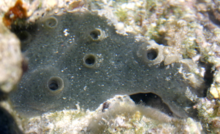
The Placozoa are a basal form of marine free-living (non-parasitic) multicellular organism. They are the simplest in structure of all animals. Three genera have been found: the classical Trichoplax adhaerens, Hoilungia hongkongensis, and Polyplacotoma mediterranea, where the last appears most basal. The last two have been found only since 2017. Although the Placozoa were first discovered in 1883 by the German zoologist Franz Eilhard Schulze (1840–1921) and since the 1970s more systematically analyzed by the German protozoologist Karl Gottlieb Grell (1912–1994), a common name does not yet exist for the taxon; the scientific name means "flat animals".

Sponges, the members of the phylum Porifera, are a basal animal clade as a sister of the Diploblasts. They are multicellular organisms that have bodies full of pores and channels allowing water to circulate through them, consisting of jelly-like mesohyl sandwiched between two thin layers of cells.
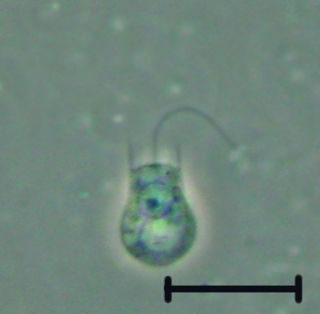
The choanoflagellates are a group of free-living unicellular and colonial flagellate eukaryotes considered to be the closest living relatives of the animals. Choanoflagellates are collared flagellates having a funnel shaped collar of interconnected microvilli at the base of a flagellum. Choanoflagellates are capable of both asexual and sexual reproduction. They have a distinctive cell morphology characterized by an ovoid or spherical cell body 3–10 µm in diameter with a single apical flagellum surrounded by a collar of 30–40 microvilli. Movement of the flagellum creates water currents that can propel free-swimming choanoflagellates through the water column and trap bacteria and detritus against the collar of microvilli, where these foodstuffs are engulfed. This feeding provides a critical link within the global carbon cycle, linking trophic levels. In addition to their critical ecological roles, choanoflagellates are of particular interest to evolutionary biologists studying the origins of multicellularity in animals. As the closest living relatives of animals, choanoflagellates serve as a useful model for reconstructions of the last unicellular ancestor of animals.

Demosponges are the most diverse class in the phylum Porifera. They include 76.2% of all species of sponges with nearly 8,800 species worldwide. They are sponges with a soft body that covers a hard, often massive skeleton made of calcium carbonate, either aragonite or calcite. They are predominantly leuconoid in structure. Their "skeletons" are made of spicules consisting of fibers of the protein spongin, the mineral silica, or both. Where spicules of silica are present, they have a different shape from those in the otherwise similar glass sponges. Some species, in particular from the Antarctic, obtain the silica for spicule building from the ingestion of siliceous diatoms.

Coelenterata is a term encompassing the animal phyla Cnidaria and Ctenophora. The name comes from Ancient Greek κοῖλος (koîlos) 'hollow', and ἔντερον (énteron) 'intestine', referring to the hollow body cavity common to these two phyla. They have very simple tissue organization, with only two layers of cells, and radial symmetry. Some examples are corals, which are typically colonial, and hydrae, jellyfish, and sea anemones, which are solitary. Coelenterata lack a specialized circulatory system relying instead on diffusion across the tissue layers.
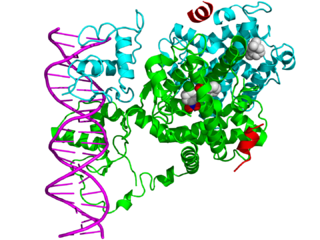
In the field of molecular biology, nuclear receptors are a class of proteins found within cells that are responsible for sensing steroid and thyroid hormones and certain other molecules. In response, these receptors work with other proteins to regulate the expression of specific genes, thereby controlling the development, homeostasis, and metabolism of the organism.
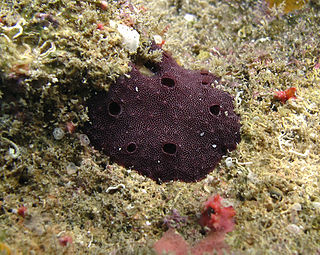
Dendroceratida is an order of sponges of the class Demospongiae. They are typically found in shallow coastal and tidal areas of most coasts around the world. They are generally characterized by concentric layers of fibers containing spongin, and by large flagellated chambers that open directly into the exhalant canals. Along with the Dictyoceratida, it is one of the two orders of demosponges that make up the keratose or "horny" sponges, in which a mineral skeleton is minimal or absent and a skeleton of organic spongin-containing fibers is present instead.

Homosclerophorida is an order of marine sponges. It is the only order in the monotypic class Homoscleromorpha. The order is composed of two families: Plakinidae and Oscarellidae.

Spicules are structural elements found in most sponges. Sponge spicules are made of calcium carbonate or silica. Large spicules visible to the naked eye are referred to as megascleres, while smaller, microscopic ones are termed microscleres. The meshing of many spicules serves as the sponge's skeleton and thus it provides structural support and potentially defense against predators. The composition, size, and shape of spicules are major characters in sponge systematics and taxonomy.
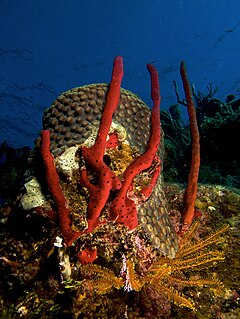
Amphimedon is a genus of sponges with over 60 described species. In 2009, Amphimedon queenslandica was the first species of sponge to have its genome sequenced.

Amphimedon compressa, the erect rope sponge, red tree sponge, red tubular sponge, or red sponge is a demosponge found in southern Florida, the Caribbean Sea, and the Bahamas. It can be deep red, orange, brown, or black.
Oscarella carmela, commonly known as the slime sponge, is a species of sponge in the order Homosclerophorida that was first described in 2004 by G. Muricy and J.S. Pearse. It is believed to be native to intertidal waters in the north east temperate Pacific Ocean and was first found in seawater aquaria in that region. It is used as a model organism in evolutionary biology.

Dictyoceratida is an order of sponges in the subclass Ceractinomorpha containing five families. Along with the Dendroceratida, it is one of the two orders of demosponges that make up the keratose or "horny" sponges, in which a mineral skeleton is minimal or absent and a skeleton of organic fibers containing spongin, a collagen-like material, is present instead.
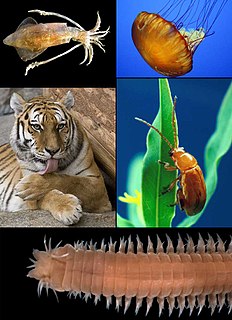
ParaHoxozoa is a clade of animals that consists of Bilateria, Placozoa, and Cnidaria. The relationship of this clade relative to the two other animal lineages Ctenophora and Porifera is debated. Some phylogenomic studies have presented evidence supporting Ctenophora as the sister to Parahoxozoa and Porifera as the sister group to the rest of animals. Some studies have presented evidence supporting Porifera as the sister to Parahoxozoa and Ctenophora as the sister group to the rest of animals. The tree below, which is congruent with the vast majority of these phylogenomic studies, conveys this uncertainty with a polytomy.

Until the late 1950s, the Precambrian was not believed to have hosted multicellular organisms. However, with radiometric dating techniques, it has been found that fossils initially found in the Ediacara Hills in Southern Australia date back to the late Precambrian. These fossils are body impressions of organisms shaped like disks, fronds and some with ribbon patterns that were most likely tentacles.

Agelas tubulata is a species of demosponge. It is tube-shaped or vase-shaped and variable in colour. It is found in the Caribbean area and along the coasts of Brazil at depths of between about 70 and 90 m. It was first described by Lehnert & Rob van Soest in 1996, the type location being the Greater Antilles.
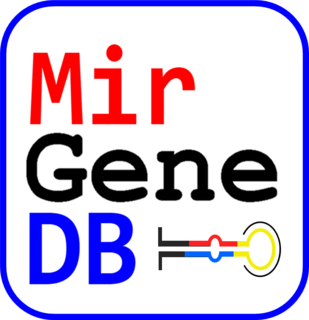
MirGeneDB is a database of manually curated microRNA genes that have been validated and annotated as initially described in Fromm et al. 2015 and Fromm et al. 2020. MirGeneDB 2.1 includes more than 16,000 microRNA gene entries representing more than 1,500 miRNA families from 75 metazoan species and published in the 2022 NAR database issue. All microRNAs can be browsed, searched and downloaded.

Jose V. Lopez is an American-Filipino molecular biologist. He has been faculty and professor of biology at Nova Southeastern University (NSU). in Dania Beach FL since 2007. Lopez co-founded the Global Invertebrate Genomics Alliance (GIGA) community of scientists and participated in the Porifera Tree of Life and Earth Microbiome Projects.
Gert Wörheide is a German marine biologist who works mainly on marine invertebrates. He earned his doctorate in geobiology from Georg-August-Universität, following this with a post-doctorate at Queensland Museum (1998-2002), where he worked with John Hooper on sponges, a collaboration which continues.
